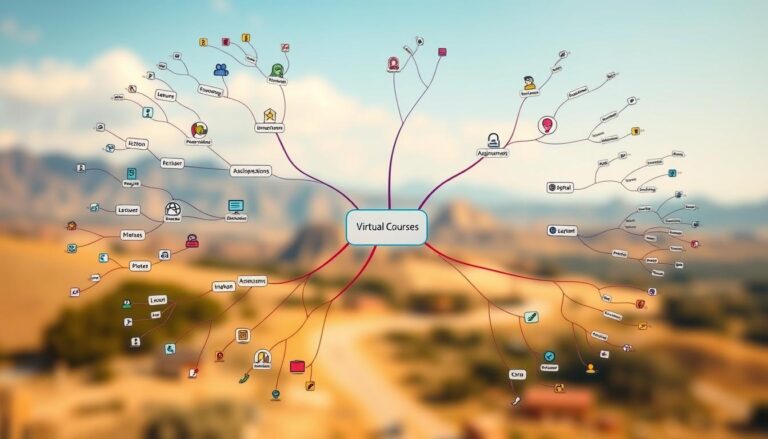Parent’s Guide to Becoming a Virtual Learning Coach
More parents are turning to online learning options as a flexible and accessible way to educate their children. This shift from traditional classrooms to online environments empowers families with the freedom to learn from home, balancing education with other commitments. Many online schools in America offer tuition-free public options, providing high-quality education without financial strain.
Online education is distinct from emergency remote learning, offering structured programs with interactive resources like simulations, games, and video lectures. This guide will walk you through the tools, enrollment steps, and state-specific requirements to support your child effectively. We are here to help you navigate this journey with confidence and expertise.
By following this guide, you’ll discover how to create a nurturing environment that fosters academic growth and personal development. Let’s take this step together to ensure your child thrives in their online learning experience.
Understanding the Modern Online Education Landscape in India
Online education in India has undergone remarkable transformation over the past decade, reshaping how students learn and engage with educational content. This shift has been driven by advancements in technology and the growing need for flexible learning solutions.
Evolution of Virtual Learning and E-Learning Trends
The journey from traditional classrooms to modern online platforms has been both rapid and impactful. E-learning in India has evolved significantly, with platforms now offering interactive content, real-time interactions, and personalized learning experiences. For instance, the “Internet Saathi” project has empowered rural communities by providing digital literacy training, enabling access to educational resources through smartphones.
Today, e-learning platforms cater to diverse segments, from K-12 education to vocational training. This shift has been further accelerated by initiatives like the National Education Policy (NEP), which emphasizes technology-enabled learning, and the Digital India campaign, which has improved internet accessibility across the country.
Impact on Traditional Classroom Settings
The rise of online education has disrupted conventional classroom models, offering students more flexibility and accessibility. Virtual schools now provide tuition-free programs, making education more affordable for many families. Additionally, the incorporation of social-emotional learning structures in online schools addresses barriers such as social anxiety, creating a more inclusive environment for learners.
Research indicates that students retain 25-60% of information in virtual classes, compared to just 8-10% in traditional settings. This improvement, coupled with the ability to progress at their own pace, has made online learning a preferred choice for many. Moreover, the elimination of daily commutes saves time and energy, benefiting both students and families.
The integration of technology in virtual schooling fosters essential tech skills, preparing students for future job markets. With a wider variety of courses available, students can explore their interests more freely. This shift not only enhances academic outcomes but also promotes better time management skills, crucial for long-term success.
In conclusion, the modern online education landscape in India reflects a blend of innovation and accessibility, offering numerous benefits for both educators and learners. As technology continues to advance, the future of online education promises even greater opportunities for growth and development.
Virtual School State Requirements: A Complete Guide
Understanding the regulations for online education is crucial for a smooth enrollment process. Each state has specific rules that govern virtual schooling, ensuring compliance and quality education.
Overview of State Guidelines
Currently, 36 states offer full-time online schools, providing tuition-free public options. These programs adhere to state standards, ensuring a high-quality education. Parents must review their state’s regulations to ensure compliance, as requirements can vary significantly.
Enrollment Process and Key Considerations
The enrollment process typically involves submitting documents like proof of residency and academic records. Some states require standardized test scores, while others may have specific course load requirements. For instance, full-time programs often mandate a standard course load, mirroring traditional schools.
The Parent’s Role in Meeting Requirements
Parents play a vital role in ensuring their child meets all state guidelines. This includes managing enrollment, maintaining communication with the school, and overseeing their child’s progress. Regular check-ins with teachers and staying informed about deadlines are essential for a successful online learning experience.
For more detailed information on enrolling your child in an online school, visit this resource to explore options and guidelines specific to your state.
Benefits and Challenges of Virtual Schooling
As online learning continues to evolve, it brings both exciting opportunities and notable challenges for students and families. Understanding these aspects is key to making informed decisions about your child’s education.
Advantages for Students and Families
One of the most significant benefits of online schools is their flexibility. Students can learn at their own pace, balancing school with family life and other commitments. This flexibility is especially valuable for families seeking to create a routine that works for everyone.
Online learning also offers personalized experiences tailored to individual needs. With access to diverse resources, students can explore subjects in-depth, fostering a love for learning. For instance, programs like the Florida Virtual School have shown how personalized learning can lead to higher engagement and academic success.
Moreover, online education bridges gaps in access, allowing students in remote areas to enjoy the same quality of education as those in urban centers. This inclusivity helps level the educational playing field.
Common Obstacles and Solutions
Despite its advantages, virtual schooling presents challenges. Technical issues and self-motivation are common hurdles. To address these, families can create dedicated study spaces and use digital tools to stay organized and connected.
Parents play a crucial role in helping students stay motivated. Setting clear goals and maintaining open communication with teachers can provide the necessary support. By fostering a structured yet flexible environment, families can turn challenges into growth opportunities.
In conclusion, while virtual schooling offers flexibility and personalized learning, it also requires proactive strategies to overcome obstacles. With the right approach, families can navigate this educational landscape successfully.
Navigating the Online Learning Environment
Understanding the dynamics of online learning is essential for both parents and students to make the most of this educational journey. The online learning environment is shaped by two primary models: synchronous and asynchronous learning. Grasping these concepts helps in creating a structured and effective learning experience.
Understanding Synchronous versus Asynchronous Models
Synchronous learning happens in real-time, where students and teachers interact live. This model uses tools like video conferencing (e.g., Zoom or Google Meet) and live chats, allowing immediate interaction. It’s ideal for students who thrive on structure and direct communication.
Asynchronous learning, on the other hand, is self-paced. Students complete tasks and watch recordings on their own schedule, using platforms like Moodle or Canvas. This flexibility is perfect for those who need to balance learning with other responsibilities.
Leveraging Technology for Effective Learning
Technology plays a crucial role in enhancing the online learning experience. Interactive tools like simulations, educational games, and video lectures keep students engaged. Learning Management Systems (LMS) help organize coursework, while tools like Kahoot! make learning interactive and fun.
Parents can help by creating a dedicated study space and ensuring reliable internet access. Encouraging regular check-ins with teachers and using digital calendars can keep students on track and engaged.
By understanding these models and leveraging technology, parents can support their child’s learning effectively, fostering an environment that promotes academic success and personal growth.
Step-by-Step Guide for Parents on Transitioning to Online School
Transitioning your child to an online school can feel overwhelming, but with the right approach, it can be a smooth and successful process. We’ve put together a clear, step-by-step guide to help you navigate this journey with confidence.
Reviewing and Understanding Your State’s Guidelines
Every state has specific rules for online education. Start by visiting your state’s education website to understand these guidelines. For example, some states offer tuition-free online schools, while others may require specific documentation. Understanding these rules will help you avoid any surprises during enrollment.
Take time to review the curriculum and ensure it aligns with your child’s academic goals. If you have questions, don’t hesitate to reach out to the school’s support team for clarification.
Connecting with Institutions and Managing Enrollment
Once you’ve chosen an online school, it’s time to connect with the institution. Start by visiting their website to learn more about their programs and enrollment process. Many online schools offer virtual tours or information sessions to help you get a better understanding of their offerings.
When you’re ready to enroll, gather all necessary documents, such as proof of residency, academic records, and immunization records. Some states may also require standardized test scores. Be sure to submit these documents well in advance of the deadline to ensure a smooth transition.
For more information on enrolling your child in an online school, visit this resource to explore options and guidelines specific to your needs.
Managing the Transition Process
After enrollment, it’s important to stay organized. Create a checklist to keep track of deadlines, such as completing orientation, setting up your child’s learning environment, and establishing communication with teachers. Regularly check in with your child to ensure they’re adjusting well to the new learning environment.
Remember, transitioning to online school is a process, and it’s okay to take it one step at a time. By staying informed, connected, and proactive, you can help your child thrive in their online learning journey.
Essential Tools and Resources for Online Learning
Online learning is supported by a variety of tools and platforms designed to enhance the educational experience. These resources play a crucial role in fostering engagement and academic success for students.
Learning Management Systems and Digital Platforms
Learning Management Systems (LMS) are central to online education. Platforms like EducateMe’s software offer integrated tools such as video conferencing and content management. These systems allow teachers to post assignments, grades, and resources, while students can submit work and participate in discussions. Key features include:
- Interactive dashboards for tracking progress
- Real-time communication tools
- Access to a library of educational resources
Such platforms create a structured environment that supports both teachers and students, making online learning more manageable and effective.
Accessing Course Materials and Interactive Tools
Quality course materials are essential for academic growth. Many online schools provide access to interactive tools like simulations, educational games, and video lectures. These tools keep students engaged and make complex concepts easier to understand. For example, platforms offering real-time feedback help students assess their performance and identify areas for improvement.
By leveraging these tools, students can enjoy a balanced and interactive learning environment that promotes development and success.
Creating an Effective Home Learning Environment
Designing a home learning environment that supports your child’s education is crucial for their success in online school. A well-structured space can enhance focus, reduce distractions, and create a positive atmosphere for learning.
Designing a Quiet and Dedicated Study Space
A quiet, distraction-free area is essential for effective learning. Consider converting a corner of your home into a dedicated study space with minimal noise and few distractions. Ensure the area is well-lit, either naturally or with good artificial lighting, and equipped with necessary resources like a desk, chair, and reliable internet connection.
Personalizing the space to your child’s needs can also boost their engagement. For example, adding a bulletin board for reminders or a shelf for textbooks can make the area more functional and organized.
Balancing Routine, Flexibility, and Parental Supervision
While online learning offers flexibility, establishing a structured routine helps maintain consistency. Create a schedule that includes dedicated learning times, breaks, and physical activities to keep your child engaged and active.
- Incorporate regular breaks to prevent burnout and maintain focus.
- Encourage physical activity to refresh the mind and body.
- Monitor progress without being overbearing to ensure your child stays on track.
By combining structure with flexibility, you can create a balanced environment that supports your child’s academic growth while allowing them to thrive independently.
For more insights on creating an effective learning environment, visit this resource to explore tools and strategies that can enhance your child’s online education experience.
Building a Virtual Learning Coach Mindset
Empowering parents to embrace the role of a virtual learning coach is key to supporting their child’s educational journey. This mindset shift involves adopting proactive strategies, fostering open communication, and leveraging available resources to create a nurturing environment for online learning.
Developing Support Strategies for Virtual Learning
Successful virtual learning coaches understand the importance of balance and flexibility. By establishing a structured routine that allows for adaptability, parents can help their children stay on track without feeling overwhelmed. Breaking tasks into manageable steps and celebrating small achievements can boost motivation and confidence.
- Create a dedicated learning space free from distractions.
- Encourage time management skills through digital calendars and checklists.
- Stay proactive by regularly reviewing progress and addressing challenges early.
Parents should also focus on fostering independence by gradually handing over responsibility to the child, allowing them to take ownership of their learning. This approach not only builds self-reliance but also prepares them for future academic and professional challenges.
Fostering Communication with Educators and Students
Clear and consistent communication is the cornerstone of effective virtual learning. Parents should maintain regular contact with teachers to stay informed about their child’s progress and any emerging needs. This collaborative approach ensures that everyone is aligned and working towards common goals.
Encouraging open dialogue with the child is equally important. Parents should create opportunities for their child to express concerns, ask questions, and share experiences. This not only strengthens the parent-child relationship but also helps in identifying areas where additional support may be needed.
By adopting these strategies, parents can create a supportive and inclusive environment that promotes academic success and personal growth. A proactive mindset, combined with effective communication, empowers both parents and students to thrive in the virtual learning landscape.
Expert Tips and Strategies for Supporting Your Child’s Online Education
Supporting your child’s online education requires a combination of effective strategies and a nurturing approach. By implementing expert-backed techniques, you can create an environment that fosters engagement, motivation, and continuous growth.
Proven Techniques for Engagement and Motivation
Engagement is key to successful online learning. Break lessons into manageable chunks to prevent overwhelm and maintain focus. Interactive tools like educational games and simulations can make learning fun and dynamic. Encourage your child to take ownership of their learning by setting small, achievable goals.
- Use digital calendars for time management
- Incorporate breaks to avoid burnout
- Encourage physical activity for a refreshed mind
These strategies help create a balanced routine that supports academic success while allowing for personal growth.
Feedback, Assessment, and Continuous Improvement
Regular feedback is crucial for tracking progress and understanding areas that need improvement. Use assessments to identify strengths and weaknesses, then adjust the learning plan accordingly. Open communication with teachers ensures everyone is aligned and working toward common goals.
By leveraging data and evaluations, you can continuously refine your child’s learning experience, ensuring they stay on track and thrive in their online education journey.
Conclusion
As we conclude this journey into the world of online education, it’s clear that this path offers immense opportunities for growth and flexibility. By understanding your state’s guidelines, exploring enrollment options, and leveraging the right tools, you can create a nurturing environment for your child’s education.
The benefits of online learning are undeniable—flexibility, personalized experiences, and access to diverse courses. However, success in this environment requires proactive strategies. Parents play a vital role in maintaining structure, fostering communication, and ensuring their child stays motivated.
Remember, you’re not alone in this journey. With the wealth of resources and expert strategies available, you’re well-equipped to support your child’s online education. From interactive platforms to structured routines, the tools are in place to help your child thrive.
As you move forward, embrace the role of a virtual learning coach with confidence. Stay informed, engage with educators, and celebrate every step of progress. Together, we can empower the next generation to succeed in this dynamic educational landscape.
For further insights and resources, explore our collection of articles and guides designed to support your child’s educational journey. Let’s take this step together toward a brighter, more accessible future in education.







